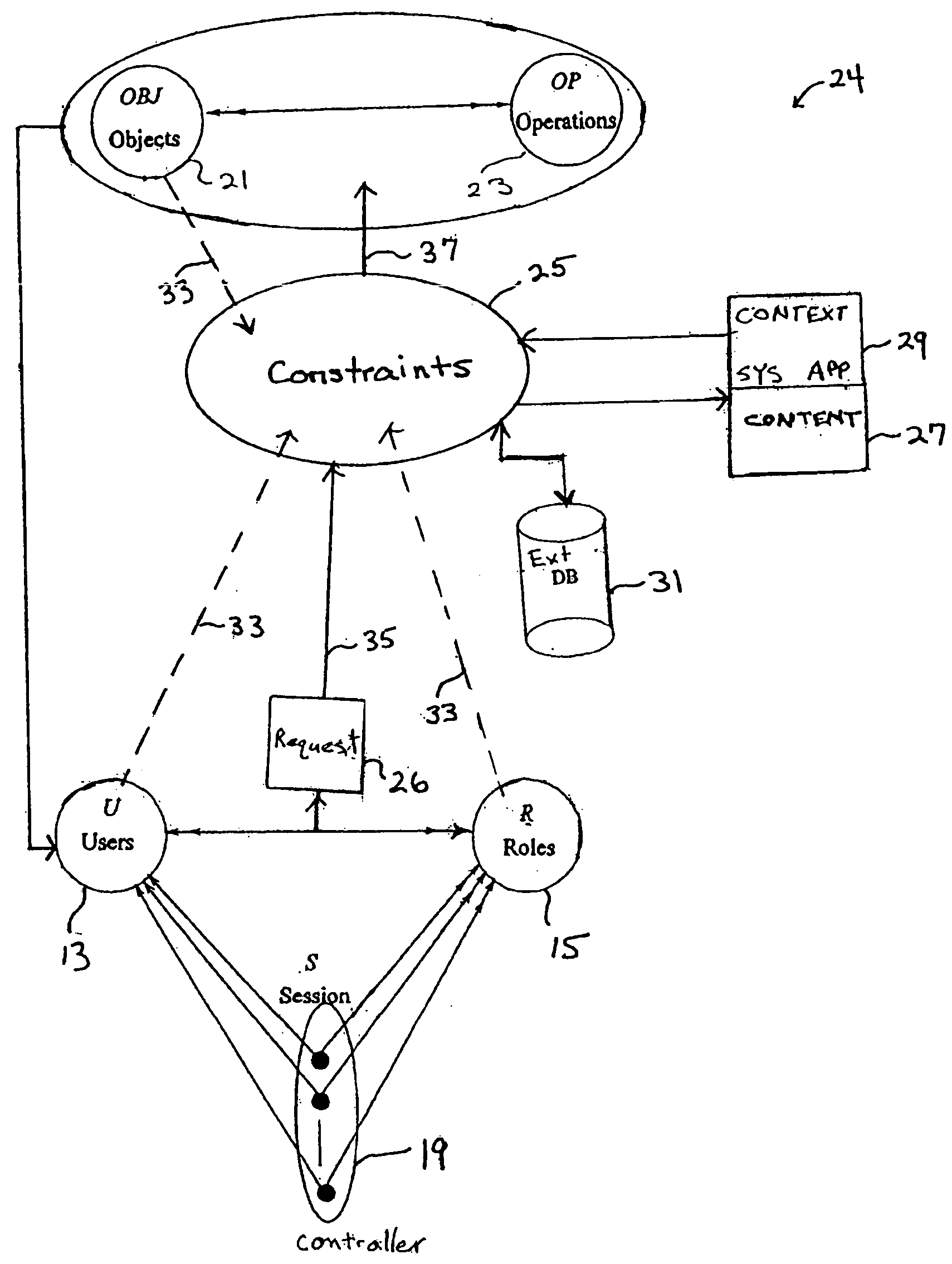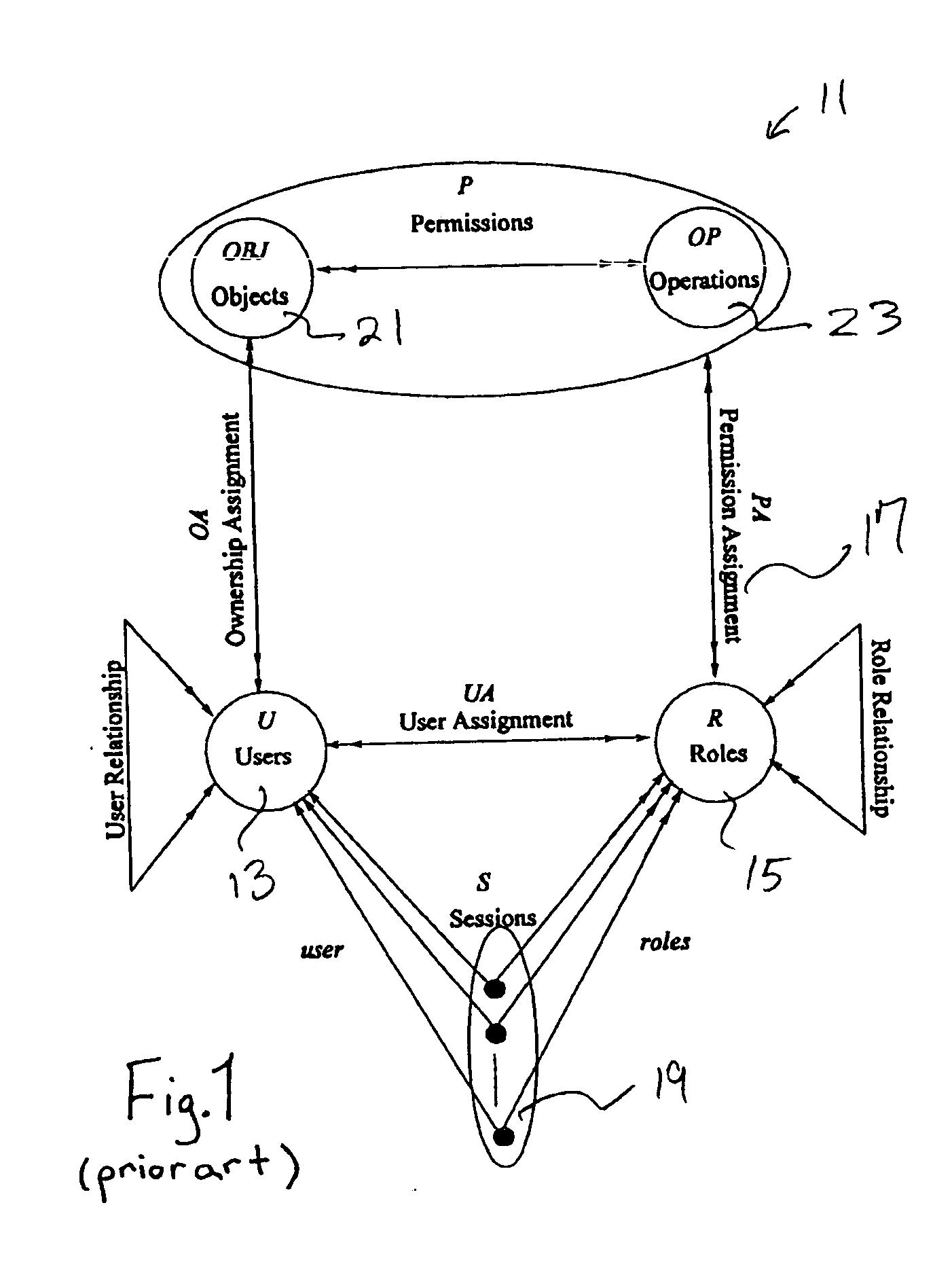Refined permission constraints using internal and external data extraction in a role-based access control system
a permission control system and data extraction technology, applied in the field of system or method of role based access control, can solve the problems of not being able to enable system administrators to establish highly flexible, known rbac systems have not utilized entire content categories, and rbac systems have not enabled system administrators to use context within all information categories, etc., to achieve the effect of enhancing the content availabl
- Summary
- Abstract
- Description
- Claims
- Application Information
AI Technical Summary
Benefits of technology
Problems solved by technology
Method used
Image
Examples
example 1
[0032] Head nurses can view all their department doctors' patients' medical records, except the medical records of the immediate family of said head nurses' colleagues within the same department.
[0033] Such a determination of colleagues may require extensive user identity knowledge besides that available from the user profile provided at log-in to the session, i.e., prior to the access request. The determination of immediate family may even require retrieval of data external to the controlled computer system. A parenthetical category review of Example 1 shows: head nurses (a role, or subject information) can view (operation) all their department doctors' patients' medical records (ownership or object information and relationship context of doctor and nurse), except (constraint on access) the medical records (objects) of their colleague's immediate family (possible environment or subject information or both, and including content and context) in the same department.
[0034] Therefore...
example 2
[0051] Medical researchers can only view records of patients who have taken some medicines that are the subject of the researchers' study.
[0052] For this constraint, determining user access within the role's permission requires extensive knowledge about the record's content, i.e., medicines, and information about the individual user (subject) and the user's studies (likely to be environmental content stored outside the controlled computer system). A parenthetical category review of Example 2 shows: Medical researchers (role) can only (constraint) view (operations) records of patients (object) who have taken some medicines (object content) that are the subject of the researchers' (subject content) study (environment content).
[0053] Therefore, when: [0054] Patient-Record: O [0055] Roles: R={Researcher}[0056] Operations: OP={view, append, copy}[0057] Application Context: [0058] Relationship: rcr=Role-RecordContent Relationship;
in a formal specification, the role-Permission Assignme...
example 3
[0061] Medical researchers can only view records of patients who exhibit similar symptoms as those exhibited by patients who suffer from the SARS Disease.
[0062] For this constraint, determining user access requires external access to databases that describe symptoms for the SARS disease. A parenthetical category review of Example 3 shows: Medical researchers (role) can only (constraint) view (operation) records of patients (object) who exhibit similar symptoms (object content) as those exhibited by patients who suffer from the SARS Disease (environment content).
[0063] Therefore, when: [0064] Patient-Record: O [0065] Roles: R={Researcher}[0066] Operations: OP={view, append, copy}[0067] Application Context: [0068] Relationship: [0069] rcr=Role-RecordContent Relationship [0070] sr=similarity relationship;
in a formal specification, the role-Permission Assignment with Context Constraints may be written as: [0071] PA(Researcher, O, view) [[rcr(Researcher, symptom-content(O)) && sr(sym...
PUM
 Login to View More
Login to View More Abstract
Description
Claims
Application Information
 Login to View More
Login to View More - R&D
- Intellectual Property
- Life Sciences
- Materials
- Tech Scout
- Unparalleled Data Quality
- Higher Quality Content
- 60% Fewer Hallucinations
Browse by: Latest US Patents, China's latest patents, Technical Efficacy Thesaurus, Application Domain, Technology Topic, Popular Technical Reports.
© 2025 PatSnap. All rights reserved.Legal|Privacy policy|Modern Slavery Act Transparency Statement|Sitemap|About US| Contact US: help@patsnap.com



